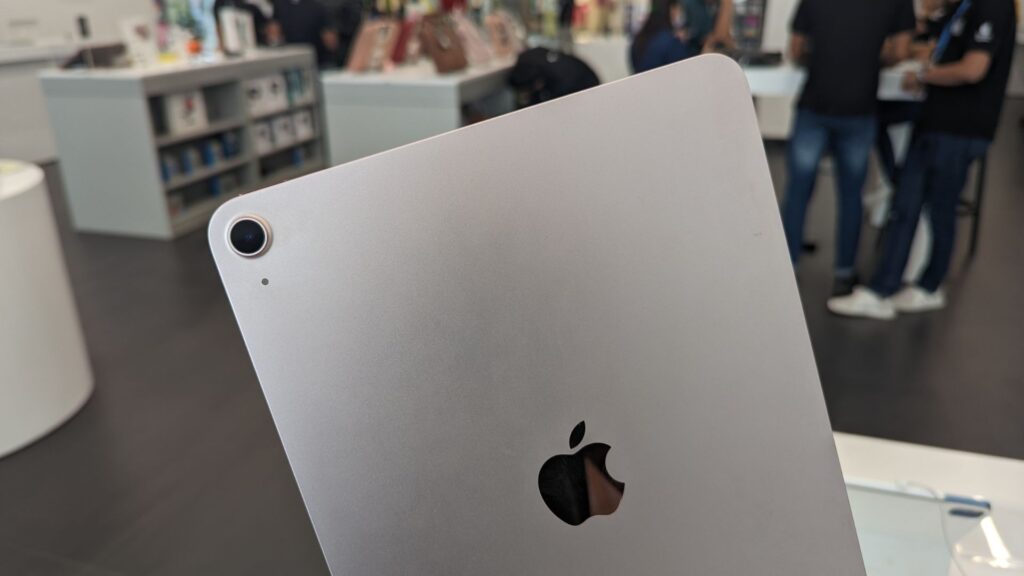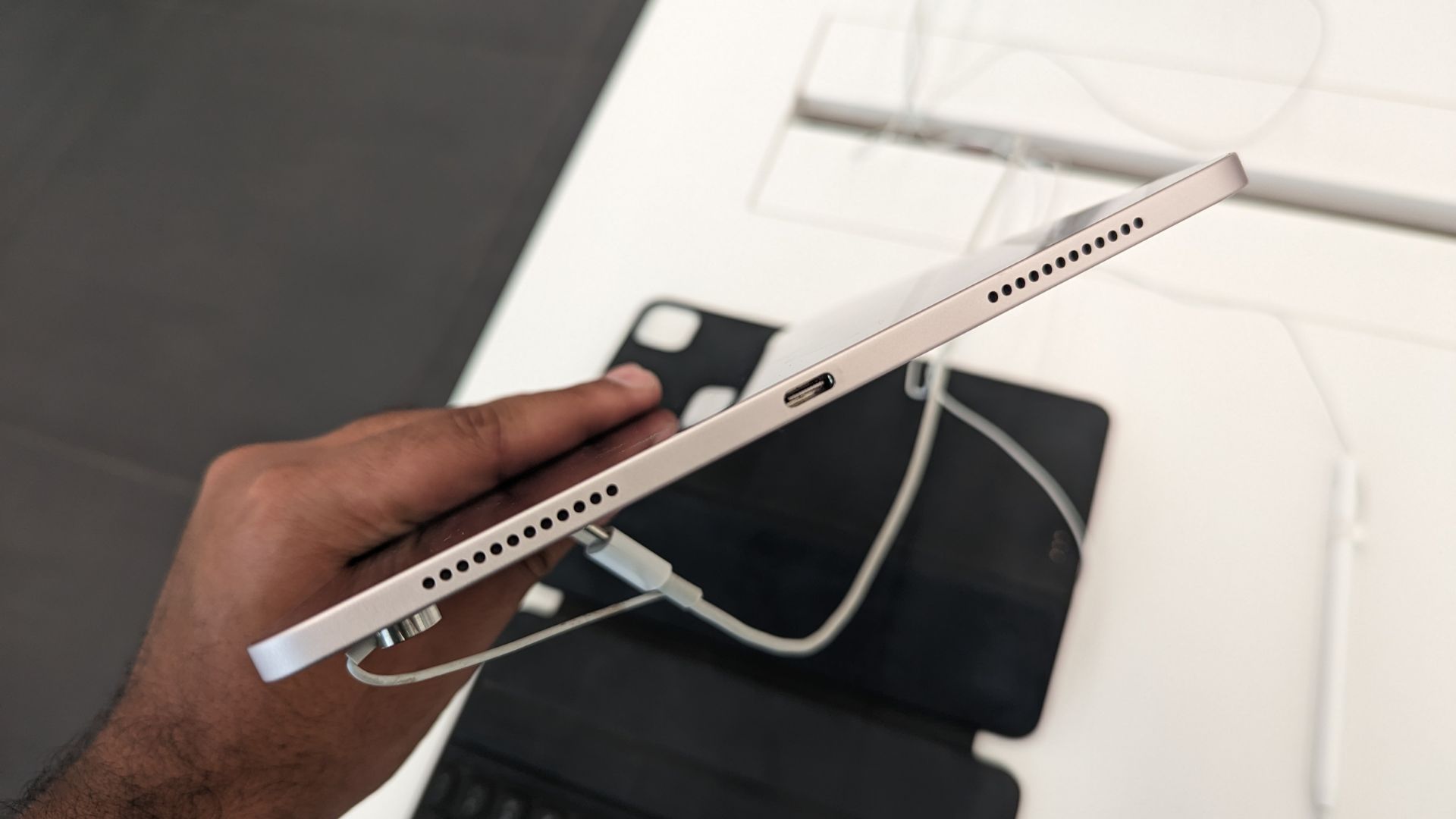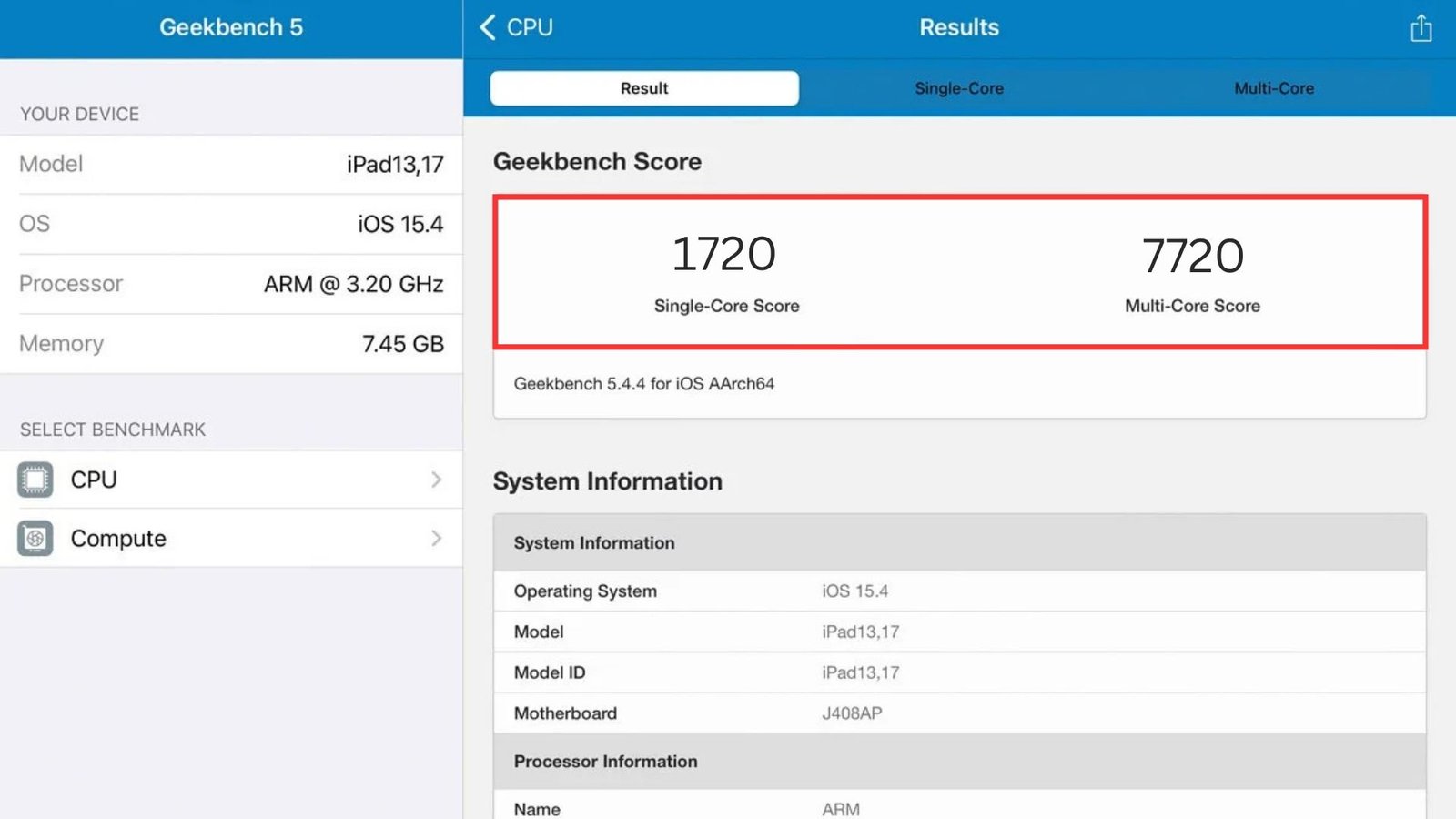A few days ago, I went to the Apple store and used the iPad Air 5 for 7-8 hours. In this article, I will share my thoughts on whether one should buy the iPad Air 5 in 2023 or not.
Specifications
| Build | Glass frontAluminum frame |
| Dimensions & Weight | 247.6 x 178.5 x 6.1 mm461g |
| Display | 10.9-inch LCD60Hz1640 x 2360 |
| SoC | Apple M1 |
| RAM & Storage | 8GB & 64/256GB |
| Battery & Charging | Battery size not disclosedWired charging up to 45W20W charging brick included |
| Security | Touch ID fingerprint sensor |
| Rear Camera(s) | 12MP, f/1.8 |
| Front Camera(s) | 12MP, ultra-wide, f/2.4 |
| Port(s) | USB-C |
| Audio | Dual Stereo Speakers |
| Connectivity | 5GBluetooth 5.0Wi-Fi 6 |
| Software | iPadOS 15.4 |
| Other Features | Compatibility with Apple Pencil (gen 2) and Magic Keyboard |
Design

When I held the iPad Air 5 in my hand, the size and design were exactly the same as the iPad Air 4. This is a very premium-looking tablet with small bezels, squared-off edges, and a 10.9-inch display with rounded corners.

On the right side of the tablet are the volume buttons, the power button is located on the top side, and the USB-C port is located on the bottom side, which has a transfer speed of 10Gbps.

The power button on the iPad Air 5 also includes Apple’s newer implementation of touch ID, same as what we had with the previous model. And of course, the iPad Pro comes with face ID instead.
When I got my first iPad Air 5, it felt exactly like the previous model in terms of build quality. And my assumption was that Apple just used the same frame as with the Air 4.
Display

The iPad Air 5 features a 10.9-inch Retina display that offers a resolution of 2360×1640, a brightness level of 500 nits, and a pixel density of 264 pixels per inch.
The iPad Air 5’s display is a P3 display, which means it has exceptional color accuracy and can be utilized for tasks such as photo and video editing.
The iPad Air 5’s display is equipped with True Tone technology, allowing it to automatically adjust the color temperature of the screen based on the ambient lighting conditions.
The iPad Air 5 retains the same 60Hz display as its predecessor. If you require a higher refresh rate of 120Hz, you will need to upgrade to the 11-inch iPad Pro, which features Apple’s ProMotion technology.
While I personally prefer a higher refresh rate of 120Hz. And at the same time, iPad Air 5’s 60Hz display has not been problematic for me, nor was it an issue with the previous model, the iPad Air 4.
Battery Life

I was initially worried about the battery life of the iPad Air 5 since it now features the powerful M1 chip. However, I was pleased to discover that the device is still capable of utilizing its high-efficiency cores for basic tasks, which helps conserve battery life.
Apple does not typically provide information about the milliamp per hour (mAh) rating of iPad batteries. Instead, they usually describe the battery life, which is consistent across iPad models. Specifically, Apple states that the iPad can last up to 10 hours when watching videos or browsing the web using Wi-Fi, and up to 9 hours when using cellular data.
Now, of course, if you push it, if you’re rendering video or doing anything that maxes out the multi-core performance then the battery is used up more quickly.
I have had a positive experience with the iPad Air 5 thus far. While it may not be quite as excellent as the iPad 9, it performs comparably to both the iPad Mini and the 11-inch iPad Pro.
Cameras

The camera system on the iPad Air 5 has not been updated, and it still features the same 12-megapixel rear-facing camera found on its predecessor, the iPad Air 4. However, the device is now capable of utilizing the enhanced Image Signal Processor (ISP) on the M1 chip, which leads to better image quality.

Unlike the rear-facing camera, Apple did upgrade the front-facing camera on the iPad Air 5. It now features the same 12-megapixel camera found on other current iPad models, resulting in improved image quality.
Additionally, the front-facing camera upgrade also introduced the “Center Stage” feature to the iPad Air 5. In case you haven’t seen this feature, essentially the ultra-wide camera can identify and track a subject as it moves around, and then zoom in and out to make sure that it’s properly framed. It’s great for video calls when you’re walking around. And it’s definitely an advantage over the previous model.
Keyboard & Stylus

In terms of accessories offered by Apple, users can opt for the Magic Keyboard and the second-generation Apple Pencil to use with the iPad Air 5. Notably, the Apple Pencil can be paired and charged on the side of the device.
Amazing Performance

Regarding everyday use, multitasking, and overall performance, the M1 chip in the iPad Air 5 is incredibly powerful. The device feels incredibly fast and responsive, and I have yet to encounter any tasks that made it feel slow or unresponsive in the two and a half months that I have been using it.
It is worth noting that the M1 chip in the iPad Air 5 not only provides a significant boost in processing power but also comes with double the RAM compared to the previous version, with 8GB of RAM. As a result, the device can easily handle a wide range of tasks and will likely remain capable for at least five to seven years.
You can also use it as an additional display for your Mac, iMac, or MacBook with a feature called Sidecar.

For single-core performance, we’re looking at 1720, and for multi-core performance, we’re getting super impressive 7220.
Storage is a Problem!
The base model of the iPad Air 5 is priced at $599 and comes with 64GB of storage. So, my concern is that although it boasts plenty of processing power, users may find themselves needing to upgrade due to limited storage. While it is possible to store files like photos and videos on the cloud, the size of apps and games is continually increasing as developers push the limits of these powerful devices. As a result, users may find that their storage needs outgrow their device’s capacity over time.
To upgrade to the 256GB version of the iPad Air 5, the price increases to $749, which is getting close to the $799 price point of the 11-inch iPad Pro. However, if a user only needs slightly more storage, upgrading to the 128GB iPad Pro for an additional $50 could be a worthwhile option to consider, even for casual use.
On the other hand, if a user requires 256GB of storage, the 11-inch iPad Pro price increases to $899, and you need to prioritize your specific needs.
What should I get instead of the iPad Air 5?
iPad Air 5 $599
-
Design
-
Display
-
Performance
-
Camera & Battery Life
-
Pricing & Storage
Final Thoughts
So, the iPad Air 5 is actually a fantastic iPad. It’s just not that different, and it was introduced into a fairly complete product line without the announcement of a new chip, without a new design, no introduction of a new camera or a new camera features, and without a better display or better speakers.
While the upgrades that the iPad Air 5 received do put it on par with the iPad Pro in terms of processing power, it is worth noting that most iPad users may not necessarily be looking for improved performance alone. Other factors, such as display quality, camera features, and speaker improvements, can also influence a user’s purchasing decision when considering an iPad model.
If Apple had made a small adjustment to the storage options of the iPad Air 5, such as offering a base model with 128GB instead of 64GB and a higher-end model with 512GB instead of 256GB, it could have had a significant impact on the device’s perceived value. This change would have given users more of what they actually need, providing an immediate and meaningful benefit to their day-to-day use of the device.
Pros
- M1 Chip is very powerful
- Front Camera with Center Stage
- Great Battery Life
Cons
- 60Hz Refresh Rate
- 64GB Base Storage is very less
- Face ID is Missing





